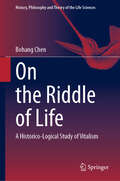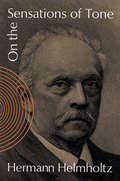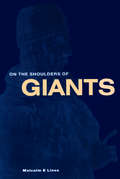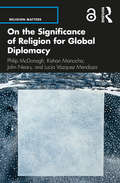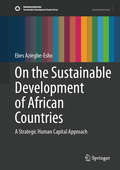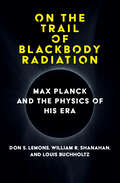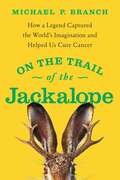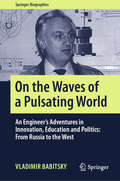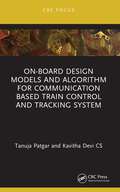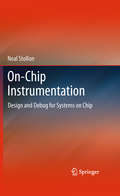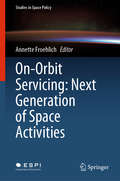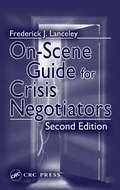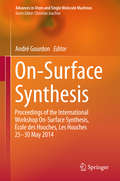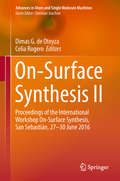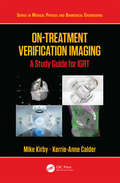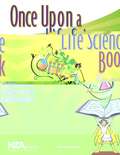- Table View
- List View
On the Revolutions of the Heavenly Spheres (Foundations)
by Copernicus Professor Marika TaylorControversial at the time, Copernicus's discoveries led to the scientific revolution, and a greater understanding of our place in the universe.An accessible, abridged edition with a new introduction. Renaissance Natural philosopher Nicolaus Copernicus's pioneering discovery of the heliocentric nature of the solar system is one of the few identifiable moments in history that define the understanding of the nature of all things. His great work was the consequence of long observation and resulted in the first stage of the Scientific Revolution by correctly positing that the earth and other planets of the solar system revolved around the sun. Not only did this promote further study to understand the place of humanity in the world and the universe, it questioned the authority of the organised Christian Church in the West to be the keeper of fundamental truths. Ultimately this would lead to the Enlightenment, and the separation of religion, government and science.The FLAME TREE Foundations series features core publications which together have shaped the cultural landscape of the modern world, with cutting-edge research distilled into pocket guides designed to be both accessible and informative.
On the Riddle of Life: A Historico-Logical Study of Vitalism (History, Philosophy and Theory of the Life Sciences #37)
by Bohang ChenThis book presents a historico-logical study of vitalism. It begins by uncovering previously unknown doctrines of vitalism from the history of science—encompassing biological, physical, and social sciences—and then subjects these doctrines to a thorough logical analysis. Through this process, the book offers a unified conceptual framework to understand the major doctrines of vitalism in the history of science, ultimately relating vitalism to the question of life. Following the classical methodological approach endorsed by Immanuel Kant, nineteenth-century philosopher-scientists like Ernst Mach, and early-twentieth-century logical analysts, including logical empiricists, British analysts, pragmatists, Husserlian phenomenologists, and neo-Kantians, this work provides unconventional and valuable perspectives on vitalism and the riddle of life, appealing to a broad audience, including scientists, historians, and philosophers of science, particularly those from biological backgrounds.
On the Scale, a Weighty Tale: A Weighty Tale (Math Is Categorical Ser.)
by Brian P. Cleary Brian GableNIMAC-sourced textbook
On the Sensations of Tone: As A Physiological Basis For The Theory Of Music (classic Reprint) (Dover Books on Music)
by Hermann HelmholtzOn the Sensations of Tone is one of the world's greatest scientific classics. It bridges the gap between the natural sciences and music theory and, nearly a century after its first publication, it is still a standard text for the study of physiological acoustics -- the scientific basis of musical theory. It is also a treasury of knowledge for musicians and students of music and a major work in the realm of aesthetics, making important contributions to physics, anatomy, and physiology in its establishment of the physical theory of music. Difficult scientific concepts are explained simply and easily for the general reader.The first two parts of this book deal with the physics and physiology of music. Part I explains the sensation of sound in general, vibrations, sympathetic resonances, and other phenomena. Part II cover combinational tones and beats, and develops Helmholtz's famous theory explaining why harmonious chords are in the ratios of small whole numbers (a problem unsolved since Pythagoras).Part III contains the author's theory on the aesthetic relationship of musical tones. After a survey of the different principles of musical styles in history (tonal systems of Pythagoras, the Church, the Chinese, Arabs, Persians, and others), he makes a detailed study of our own tonal system (keys, discords, progression of parts).Important points in this 576-page work are profusely illustrated with graphs, diagrams, tables, and musical examples. 33 appendices discuss pitch, acoustics, and music, and include a very valuable table and study of the history of pitch in Europe from the fourteenth to the nineteenth centuries.<P><P>Advisory: Bookshare has learned that this book offers only partial accessibility. We have kept it in the collection because it is useful for some of our members. To explore further access options with us, please contact us through the Book Quality link on the right sidebar. Benetech is actively working on projects to improve accessibility issues such as these.
On the Shoulders of Giants
by Lines M EOn the Shoulders of Giants investigates the relationship between the disciplines of physics and mathematics and shows how many of the most significant advances of 20th-century physics rely on mathematics developed, sometimes much earlier, with no particular physics application in mind. Quoting from mathematicians such as Poincaré and Euclid and physicists such as Newton and Feynman, the links between the two disciplines are explored in the author's entertaining style, providing a fascinating account of the twists and turns in scientific progress through the ages.
On the Significance of Religion for Global Diplomacy (Religion Matters)
by Philip McDonagh Kishan Manocha John Neary Lucia Vázquez MendozaWhat could it mean, in terms of strengthening multilateral diplomacy, if the UN, the Organisation for Security and Cooperation in Europe (OSCE), the European Union, and other regional diplomatic frameworks engaged more creatively with a religious perspective? In this ground-breaking volume it is argued that international organisations, backed by governments, can and should use their convening power to initiate new, multi-layered frameworks of engagement, inclusive of the representatives of religion. This can make multilateralism more fit for purpose and have a major impact over time on our planetary future. The book is divided into an introduction and six chapters: Towards a culture of encounter inclusive of the world’s religious traditions Structural questions in 21st-century diplomacy Knowing what we ought to know: the issues that face 21st-century diplomacy Towards the global objective of a common peace for humanity Understanding how change happens The diplomacy of the two standards The development of new frameworks of engagement A brief outline is offered of what an all-European initiative – an agora for Europe – might look like if, in the 2020s, there were the political will to inaugurate a European regional process reflecting the orientation and methodology proposed in the book. Combining cutting-edge research and reflection, with concrete recommendations for academics, religious actors, policy makers, and practitioners, this concise and accessible volume helps to build bridges between these oftentimes separated spheres of engagement.
On the Sustainable Development of African Countries: A Strategic Human Capital Approach (Sustainable Development Goals Series)
by Ebes Aziegbe-EshoDespite Africa’s vast and diverse natural resources, the developmental challenges plaguing the continent still remain. Indeed, a common factor that seems to bind all African countries together is developmental problems and challenges. From North Africa to Southern Africa, across West Africa through to Central and East Africa, African countries, especially those in Sub-Saharan Africa, are faced with the same or similar developmental challenges. Many reasons have been offered for Africa’s developmental challenges. Amongst developmental economists, the reasons range from geographical, historical, cultural, and tribal factors, to institutional factors. The unfavourable geographical landscape, its colonial and other peculiar histories, the huge diversity in culture and tribe that seem to hinder efforts at unity, and lack of good governance and the institutions of quality governance, have all been given as reasons for the inability of the continent to make good developmental progress. This book offers a strategic human capital approach as a pathway to the sustainable development of African countries. The book synthesizes different knowledge domains on human capital, and presents ways on how human capital can be strategically developed and accumulated by African countries for sustainable development. The book highlights how the continent’s growing youthful population can be strategically harnessed into human capital for sustainable development. Unlike other books on human capital and Africa’s development that rely on a single disciplinary perspective, usually from economics, this book takes a multi-disciplinary and inter-disciplinary approach. The book draws from theories and studies of human capital in economics, the originating discipline of the concept, strategic management, entrepreneurship, and Strategic Human Resources Management. Thus, it is able to present the discuss and recommendations from a holistic integration of the concept of human capital. The book also presents case studies of three countries, Singapore, Finland, and Canada, that have successfully made strategic use of human capital in their national development in different ways; another unique feature of the book. Lessons on national human capital development are drawn from each case study. Another unique feature of the book is its integration of the various global human capital indices available for a comprehensive understanding of the indices, their components, and utility for countries. Finally, the book is replete with many generic and specific recommendations on how human capital can be developed by various stake holders in Africa. A whole chapter is dedicated to generic strategic approaches to human capital development that can be adopted by African countries; and indeed, by all countries as they can be applied by other countries. The generic approaches are cumulatively drawn from resource-based theory (RBT), transaction cost economics, and human capital theory. Another chapter is also dedicated to more specific recommendations on human capital development and accumulation.
On the Trail of Blackbody Radiation: Max Planck and the Physics of his Era
by Don S. Lemons William R. Shanahan Louis J. BuchholtzAn account of Max Planck&’s construction of his theory of blackbody radiation, summarizing the established physics on which he drew.In the last year of the nineteenth century, Max Planck constructed a theory of blackbody radiation—the radiation emitted and absorbed by nonreflective bodies in thermal equilibrium with one another—and his work ushered in the quantum revolution in physics. In this book, three physicists trace Planck&’s discovery. They follow the trail of Planck&’s thinking by constructing a textbook of sorts that summarizes the established physics on which he drew. By offering this account, the authors explore not only how Planck deployed his considerable knowledge of the physics of his era but also how Einstein and others used and interpreted Planck&’s work. Planck did not set out to lay the foundation for the quantum revolution but to study a universal phenomenon for which empirical evidence had been accumulating since the late 1850s. The authors explain the nineteenth-century concepts that informed Planck&’s discovery, including electromagnetism, thermodynamics, and statistical mechanics. In addition, the book offers the first translations of important papers by Ludwig Boltzmann and Wilhelm Wien on which Planck&’s work depended.
On the Trail of the Jackalope: How a Legend Captured the World's Imagination and Helped Us Cure Cancer
by Michael P. BranchThe never-before-told story of the horned rabbit—the myths, the hoaxes, and the entirely real scientific breakthroughs it has inspired—and how it became a cultural touchstone of the American West.Just what is a jackalope? Purported to be part jackrabbit and part antelope, the jackalope began as a local joke concocted by two young brothers in a small Wyoming town during the Great Depression. Their creation quickly spread around the U.S., where it now regularly appears as innumerable forms of kitsch—wall mounts, postcards, keychains, coffee mugs, shot glasses, and so on. A vast body of folk narratives has carried the jackalope&’s fame around the world to inspire art, music, film, even erotica! Although the jackalope is an invention of the imagination, it is nevertheless connected to actual horned rabbits, which exist in nature and have for centuries been collected and studied by naturalists. Around the time the two young boys were creating the first jackalope in Wyoming, Dr. Richard Shope was making his first breakthrough about the cause of the horns: a virus. When the virus that causes rabbits to grow &“horns&” (a keratinous carcinoma) was first genetically sequenced in 1984, oncologists were able to use that genetic information to make remarkable, field-changing advances in the development of anti-viral cancer therapies. The most important of these is the human papillomavirus (HPV) vaccine, which protects against cervical and other cancers. Today, jackalopes are literally helping us cure cancer. For fans of David Quammen&’s The Song of the Dodo, Jon Mooallem&’s Wild Ones, or Jeff Meldrum's Sasquatch, Michael P. Branch's remarkable On the Trail of the Jackalope is an entertaining and enlightening road trip through the heart of America.
On the Wave Nature of Matter: A New Approach to Reconciling Quantum Mechanics and Relativity
by Donald C. ChangThis book presents a new approach to understanding the foundation of quantum physics through the "quantum wave model" hypothesis. It addresses some of the key challenges in the current quantum theory, including the conflict between quantum mechanics and relativity, and offers a comprehensive solution to many of the existing mysteries in the field. By proposing that the vacuum is a dielectric medium and quantum particles are quantized excitation waves of the vacuum, the book provides a clear physical interpretation of wave-particle duality and explains the physical basis of energy, momentum, and mass.With topics ranging from the physical foundation of quantum mechanics to the derivation of the quantum wave equations and the resolution of the conflict between quantum physics and relativity, this book offers a comprehensive overview of the most pressing issues in the field. Written at a level accessible to undergraduate students and senior researcher scientists alike,this book offers a valuable resource for anyone seeking a deeper understanding of quantum mechanics and its fundamental role in shaping our understanding of the physical world.
On the Waves of a Pulsating World: An Engineer’s Adventures in Innovation, Education and Politics: From Russia to the West (Springer Biographies)
by Vladimir BabitskyVladimir Babitsky was born before the Second World War and migrated West after Perestroika. The theory of vibro-impact systems that he developed helped create the world’s safest jackhammer and other record-breaking machines. The author has lived through a series of fascinating epochs: experiencing life under totalitarianism, witnessing the Soviet Union’s collapse, and then migrating to Europe as a specialist in his field. “On the Waves of a Pulsating World” is an animated and highly engaging story about the journey of an engineer; from childhood daydreams to creating new technologies, from East to West, and from concepts to realities. It is also the story of people who outshine authoritarianism.
On-Board Design Models and Algorithm for Communication Based Train Control and Tracking System (Power Electronics and Applications Series)
by Tanuja Patgar Kavitha Devi CSRailway systems have a long history of train protection and control, as to reduce the risk of train accidents. Many train control systems include automated communication between train and trackside equipment. But several different national systems are still facing cross-border rail traffic. Today, trains for cross-border traffic need to be equipped with train control systems that are installed on the tracks. This book covers the latest advances in Communication Based Train Control (CBTC) research in on-board components locomotive messaging systems, GPS sensors, communications wayside and switching networks. It also focuses on architecture and methodology using data fusion techniques. New wireless sensor integrated modeling techniques for tracking trains in satellite visible and low satellite visible environments are discussed. With a Tunnel Surveillance Integration model, the use of optimal control is necessary to improve train control performance, considering both train–ground communication and train control. The book begins with the background and evolution of train signaling and train control systems. It introduces the main features and architecture of CBTC systems and describes current challenging methods and successful implementations. This introductory book is very useful for Signal & Telecommunication engineers to get them acquainted with the technology used in CBTC, and help them in implementing the system suitable for Indian Railways. As this is a new technology, the information provided in this book is generic and will be subsequently revised after gaining further experience.
On-Chip Instrumentation
by Neal StollonThis book provides an in-depth overview of on chip instrumentation technologies and various approaches taken in adding instrumentation to System on Chip (ASIC, ASSP, FPGA, etc.) design that are collectively becoming known as Design for Debug (DfD). On chip instruments are hardware based blocks that are added to a design for the specific purpose and improving the visibility of internal or embedded portions of the design (specific instruction flow in a processor, bus transaction in an on chip bus as examples) to improve the analysis or optimization capabilities for a SoC. DfD is the methodology and infrastructure that surrounds the instrumentation. Coverage includes specific design examples and discussion of implementations and DfD tradeoffs in a decision to design or select instrumentation or SoC that include instrumentation. Although the focus will be on hardware implementations, software and tools will be discussed in some detail.
On-Orbit Servicing: Next Generation of Space Activities (Studies in Space Policy #26)
by Annette FroehlichThis book shares a range of new and diverse insights on On-Orbit Servicing (OOS), and examines its implications especially from political, legal, economic, and security perspectives. OSS has been evolving rapidly and presents both challenges and opportunities, such as in-space repairs, refuelling, refurbishment of spacecraft and servicing satellites, which could play a critical role in extending satellite lifecycles, while also representing a valuable next step in debris mitigation. At the same time, many legal questions have arisen in connection with OOS: the need to prevent hostile actions under the pretext of OSS; the distinction between governmental and non-governmental OOS operators; the status of re-worked and recycled space objects; the issue of control in terms of operations performed in orbit, i.e., in the international sphere; the status of objects manufactured in orbit and applicable law, including liability and registration; and the impacts on insurance law and risk management. Finally, the book examines the implications of OOS for emerging space actors in the Global South, and recommends a paradigm shift to help developing countries fully recognise the necessity and urgency of being involved in discussions on OSS, as opposed to leaving it up to the developed space actors. This book will be of great interest to practitioners, academics, and students working in the space sector and related fields.
On-Scene Guide for Crisis Negotiators
by Frederick J. Lanceley William R. CrandallAccording to author Frederick J. Lanceley one of the world's foremost crisis negotiation authorities negotiators must train and train regularly. For just as the legal field constantly evolves, so does the field of crisis negotiation. The new edition of On-Scene Guide for Crisis Negotiators reflects this fact. A bestseller in its first edition, this
On-Surface Synthesis
by André GourdonWith contributions by leading international experts, this book presents a detailed compilation of a new and very active field. It is the first book devoted to the covalent coupling of molecular precursors on surfaces that allows the preparation of 0D, 1D and 2D molecules that cannot be synthesized in solution. This book is aimed at students and researchers interested in nanochemistry and molecular devices and it gives the reader a pedagogical up-to-date vision of the most recent developments. The editor ensures a multidisciplinary approach involving molecular chemistry, surface sciences, surface spectroscopies, theory, scanning tunneling and non-contact atomic force microscopies.
On-Surface Synthesis II: Proceedings Of The International Workshop On-surface Synthesis, San Sebastián, 27-30 June 2016 (Advances In Atom And Single Molecule Machines Ser.)
by Dimas G. de Oteyza Celia RogeroOn-surface synthesis is appearing as an extremely promising strategy to create organic nanoarchitectures with atomic precision. Molecular building blocks holding adequate functional groups are dosed onto surfaces that support or even drive their covalent linkage. The surface confinement and the frequent lack of solvents (most commonly being performed under vacuum conditions) create a completely new scenario fully complementary to conventional chemistry. In a pedagogical way and based on the most recent developments, this volume presents our current understanding in the field, addressing fundamental reaction mechanisms, synthetic strategies to influence the reactions according to our needs, as well as the ultimate growth and characterization of functional materials.Verging on chemistry, physics and materials science, the book is aimed at students and researchers interested in nanochemistry, surface science, supramolecular materials and molecular devices.Chapters "Mechanistic insights into surface-supported chemical reactions", "Reactivity on and of Graphene Layers: Scanning Probe Microscopy Reviels" and "Bottom-up fabrication of atomically precise graphene nanoribbons" of this book are available open access under a CC BY 4.0 license at link.springer.com
On-Treatment Verification Imaging: A Study Guide for IGRT (Series in Medical Physics and Biomedical Engineering)
by Mike Kirby Kerrie-Anne CalderOn-treatment verification imaging has developed rapidly in recent years and is now at the heart of image-guided radiation therapy (IGRT) and all aspects of radiotherapy planning and treatment delivery. This is the first book dedicated to just this important topic, which is written in an accessible manner for undergraduate and graduate therapeutic radiography (radiation therapist) students and trainee medical physicists and clinicians. The later sections of the book will also help established medical physicists, therapeutic radiographers, and radiation therapists familiarise themselves with developing and cutting-edge techniques in IGRT. Features: Clinically focused and internationally applicable; covering a wide range of topics related to on-treatment verification imaging for the study of IGRT Accompanied by a library of electronic teaching and assessment resources for further learning and understanding Authored by experts in the field with over 18 years’ experience of pioneering the original forms of on-treatment verification imaging in radiotherapy (electronic portal imaging) in clinical practice, as well as substantial experience of teaching the techniques to trainees
Once Before Time: A Whole Story of the Universe
by Martin BojowaldBojowald recounts his discovery of loop quantum cosmology (LQC) and explains how it can illuminate the very birth of the universe.
Once Can Be Enough: Decisive Experiments, No Replication Required
by Allan Franklin Ronald LaymonThere has recently been considerable discussion of a “replication crisis” in some areas of science. In this book, the authors argue that replication is not a necessary criterion for the validation of a scientific experiment. Five episodes from physics and genetics are used to substantiate this thesis: the Meselson-Stahl experiment on DNA replication, the discoveries of the positron and the omega minus hyperon, Mendel’s plant experiments, and the discovery of parity nonconservation. Two cases in which once wasn’t enough are also discussed, the nondiscovery of parity nonconservation and the search for magnetic monopoles. Reasons why once wasn’t enough are also discussed.
Once Upon A Starry Night: A Book Of Constellations
by Jacqueline Mitton Christina BalitNational Geographic’s stunning rendition of the constellations’ glittering lightshow is now available in paperback. Take an illuminating ride through the starry night sky, and learn how the heavens pay tribute to the gods of Greek and Roman mythology. Once Upon a Starry Night explains the ten ancient figures whose legends are written large across the universe. Every page shines with Christina Balit’s vibrant art, studded with shiny stars, and provides the perfect backdrop to Jacqueline Mitton’s poetic text.
Once Upon Einstein
by Thibault DamourIt is well known that Einstein founded twentieth-century physics with his work on relativity and quanta, but what do we really know about these ground breaking ideas? How were they discovered? What should we retain today from the conceptual upheavals he initiated? Through a selection of concrete scenes taken from Einstein's life, the author offers
Once Upon a Life Science Book: 12 Interdisciplinary Activities to Create Confident Readers
by Jodi Wheeler-ToppenWheeler-Toppen, a science teacher and children's author, presents 12 inquiry-based classroom lessons to help middle school teachers improve students' reading abilities and teach science content at the same time. Each lesson consists of a science activity, a reading about an important life science concept (easier to follow than those typically found in textbooks), an application that asks students to connect the activity with what they read, and a reading comprehension exercise, such as previewing illustrations, identifying text structures, and context clues to the meanings of new words. Each lesson also includes a graphic organizer and a writing activity. Six of the lessons ask students to make a claim and support it with evidence, and an introductory chapter suggests activities to help students understand claims and evidence.
Once Upon a Time I Lived on Mars: Space, Exploration, and Life on Earth
by Kate GreeneWhen it comes to Mars, the focus is often on how to get there: the rockets, the engines, the fuel. But upon arrival, what will it actually be like?In 2013, Kate Greene moved to Mars. That is, along with five fellow crew members, she embarked on NASA’s first HI-SEAS mission, a simulated Martian environment located on the slopes of Mauna Loa in Hawai'i. For four months she lived, worked, and slept in an isolated geodesic dome, conducting a sleep study on her crew mates and gaining incredible insight into human behavior in tight quarters, as well as the nature of boredom, dreams, and isolation that arise amidst the promise of scientific progress and glory.In Once Upon a Time I Lived on Mars, Greene draws on her experience to contemplate humanity’s broader impulse to explore. The result is a twined story of space and life, of the standard, able-bodied astronaut and Greene’s brother’s disability, of the lag time of interplanetary correspondences and the challenges of a long-distance marriage, of freeze-dried egg powder and fresh pineapple, of departure and return. By asking what kind of wisdom humanity might take to Mars and elsewhere in the Universe, Greene has written a remarkable, wide-ranging examination of our time in space right now, as a pre-Mars species, poised on the edge, readying for launch.
Once Upon a Time in the West: The Corrib Gas Controversy
by Lorna Siggins'All I want is to stay where I am . . . My heart and soul are in this place.'(Willie Corduff, one of The Rossport Five)In a remote, beautiful part of the west of Ireland, a David and Goliath struggle rages between multinational oil company, Shell, and some of the local community of Rossport, County Mayo. In 1996, Enterprise Oil, subsequently bought by Shell, found a major source of valuable gas offshore in the Corrib gas field. In the attempt to build an onshore pipeline and refinery the oil giant has come into conflict with a small group of locals who, anxious about the safety of their families, the environmental impact of the project and the future of their community, are resisting Shell's plans. The eyes of the nation fell on this tiny community when, in 2005, five of the residents were jailed for refusing to allow Shell onto their land, in contempt of court orders. These men have become known as The Rossport Five.Irish Times correspondent Lorna Siggins has been covering the controversy from the beginning. No one is better placed to unravel the twists and turns of this fascinating human drama and its political, cultural and environmental shockwaves. In a new Ireland where economic logic goes largely unchallenged, the Corrib Gas pipeline controversy raises uncomfortable questions about the ways in which Ireland has changed.

